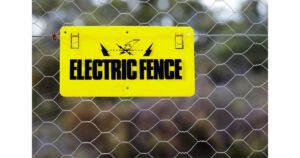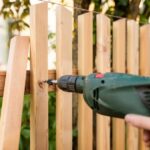How To Install Electric Dog Fence? As a dedicated pet owner, ensuring the safety and well-being of your furry companion is a top priority. While giving your dog the freedom to explore and play is essential, it’s equally important to establish boundaries to keep them safe within your property.
An electric dog fence provides a modern and effective solution to strike this balance. It has become a popular choice among dog owners due to its effectiveness and durability. Moreover, dogs can also view the surrounding environment so they don’t feel lonely.
In this comprehensive guide, we’ll walk you through the step-by-step process of installing an electric dog fence, ensuring a secure environment where your canine friend can thrive.

In this article, i will discuss
I. Introduction
II. Preparation and Planning
III. Step-by-Step Installation Guide
H2: Installing a Wired Electric Dog FenceH2: Installing a Wireless Electric Dog Fence
IV. Collar Fit and Training
V. Training Your Dog
VI. Troubleshooting and Maintenance
VII. Conclusion
So let’s start
Table of Contents
TogglePreparation and Planning
Before diving into the installation process, adequate preparation and planning are crucial to ensure a successful outcome. Consider the following steps:
Assessing Your Property
Take a thorough look at your property’s layout. Evaluate its size, shape, and any potential obstacles that might affect the installation process. This assessment will guide you in selecting the appropriate type of electric dog fence for your specific needs.
Choosing the Right Type of Electric Dog Fence
There are two main types of electric dog fences: wired and wireless systems. Wired systems involve burying a wire along the perimeter, while wireless systems emit a signal from a central transmitter. Choose the type that best suits your property layout and your dog’s behavior.
Gathering Necessary Tools and Materials
For wired systems, gather materials such as wire, flags, and connectors. Wireless systems require a transmitter and a collar for your dog. Having all the necessary tools and materials on hand will streamline the installation process.
How To Install Electric Dog Fence? Step-by-Step Installation Guide
Installing a Wired Electric Dog Fence
1. Measuring and Marking Boundaries: Determine where you want the boundaries to be. Mark the perimeter by placing flags along the boundary line. This visual cue will help guide you during the wire installation.
2. Burying the Wire: Dig a trench along the marked boundary, ensuring it’s deep enough to accommodate the wire. Secure the wire in the trench and cover it with soil, ensuring the wire is completely buried to avoid any tripping hazards.
3. Connecting the Wire to the Transmitter: Indoors, locate a suitable spot for the transmitter. Attach the wire to the transmitter, following the manufacturer’s instructions. This connection establishes the boundary signal.
4. Testing the System: Turn on the transmitter and put the collar on your dog. Walk around the perimeter, gradually approaching the boundary. The collar should emit a warning tone followed by static correction if your dog gets too close to the boundary how to install electric dog fence.
Installing a Wireless Electric Dog Fence
1. Choosing the Transmitter Location: Select a central and elevated location for the transmitter. This ensures optimal signal coverage and minimal interference. Avoid placing the transmitter near large metal objects or electronic devices that could disrupt the signal.
2. Setting the Boundaries: Adjust the signal range on the transmitter to define the boundaries. Use visual cues like flags to mark the perimeter. These flags will serve as a visual guide for your dog during training.
3. Testing the System: Turn on the transmitter and put the collar on your dog. Walk around the perimeter to ensure the collar emits the warning tone and correction when your dog approaches the boundary.
Collar Fit and Training
Ensuring the proper fit of the collar is essential for effective boundary training. Follow these steps:
1. Fitting the Collar Properly: Ensure the collar fits snugly but comfortably around your dog’s neck. Check that the contact points are in direct contact with your dog’s skin.
2. Introducing Your Dog to the System: Allow your dog to explore the designated area without the collar first. Once they are comfortable, put the collar on and let them wear it without activating the correction. This helps them associate the collar with positive experiences.

Training Your Dog
1. Basic Training Commands: Teach your dog basic commands like “Stay” and “Come.” Use positive reinforcement techniques, rewarding them for following commands and staying within the designated area.
2. Testing the Boundaries with Supervision: With the collar on, walk your dog near the flags that mark the boundary. When they approach the flags, guide them back using verbal cues and positive reinforcement.
3. Gradual Exposure: As your dog becomes more familiar with the boundaries, allow controlled interactions near the boundary. Praise and reward them for staying within the safe zone.
Troubleshooting and Maintenance
To ensure the ongoing effectiveness of your electric dog fence, follow these maintenance steps:
1. Monitoring Collar Fit: Regularly check the collar’s fit to prevent discomfort or skin irritation. Ensure the contact points are clean and functioning correctly.
2. Addressing False Positives and Negatives: If your dog experiences false corrections or doesn’t respond to the system, troubleshoot potential interference sources like metal objects or electronic devices. Adjust the system settings as needed.
3. Regular System Checks: Periodically test the system by walking your dog around the perimeter. Replace batteries in the collar as required to maintain the collar’s functionality.
Conclusion
Installing an electric dog fence is a thoughtful investment in your dog’s safety and well-being. By following the steps outlined in this guide, you can establish secure boundaries while giving your dog the freedom they deserve. Proper preparation, installation, collar fit, training, and maintenance are key to the system’s success.
Remember, the goal is to provide a safe and happy environment for your furry companion to thrive and explore within defined limits.
FAQ 1: How do I decide between a wired and a wireless electric dog fence?
Answer: The choice between wired and wireless fences depends on your property’s layout and your dog’s behavior. Wired systems involve burying a wire along the perimeter, making them suitable for custom boundaries.
Wireless systems emit a signal from a central transmitter and are easier to set up but might have limitations in coverage and accuracy.
FAQ 2: Do I need any special tools to install an electric dog fence?
Answer: Yes, the tools you’ll need include a trencher or shovel for burying wire (wired systems), flags to mark boundaries, wire connectors, a collar receiver for your dog, and a transmitter. You might also need a wire tester to ensure the system is functioning correctly.
FAQ 3: How deep should I bury the wire for a wired electric dog fence?
Answer: Bury the wire approximately 1 to 3 inches deep, ensuring it’s covered with soil to prevent tripping hazards or accidental damage. A shallow trench is sufficient for the wire to emit signals effectively while keeping it protected.
FAQ 4: What is the proper placement for the transmitter in a wireless system?
Answer: Choose a central and elevated location for the transmitter, ideally indoors near a power outlet. This location ensures a consistent signal throughout your property and minimizes interference.
FAQ 5: Can I install an electric dog fence myself, or should I hire a professional?
Answer: Homeowners can install both wired and wireless systems. Wireless systems are easier to set up, while wired systems might require more effort. If you’re unsure about burying wires or have a complex property layout, professional installation for wired systems is recommended.
FAQ 6: How do I know if the electric dog fence is working correctly?
Answer: After installation, test the system by walking your dog around the perimeter with the collar on. You should hear a warning tone followed by static correction as your dog approaches the boundary. If you’re uncertain, refer to the manufacturer’s guidelines for testing and troubleshooting.
FAQ 7: What is the training process for my dog after installing the fence?
Answer: Training your dog is essential for the system’s effectiveness. Start by introducing your dog to the boundaries without the collar. Then, with the collar on, guide your dog away from the boundary using positive reinforcement. Gradually allow controlled interactions near the boundary, rewarding your dog for staying within the safe zone.
FAQ 8: How often do I need to check and maintain the electric dog fence?
Answer: Regular maintenance is crucial. Monitor the collar’s fit to prevent discomfort and check the contact points for cleanliness. Address false positives or negatives by troubleshooting interference sources. Test the system periodically by walking your dog around the perimeter, and replace collar batteries as needed to ensure consistent performance.







